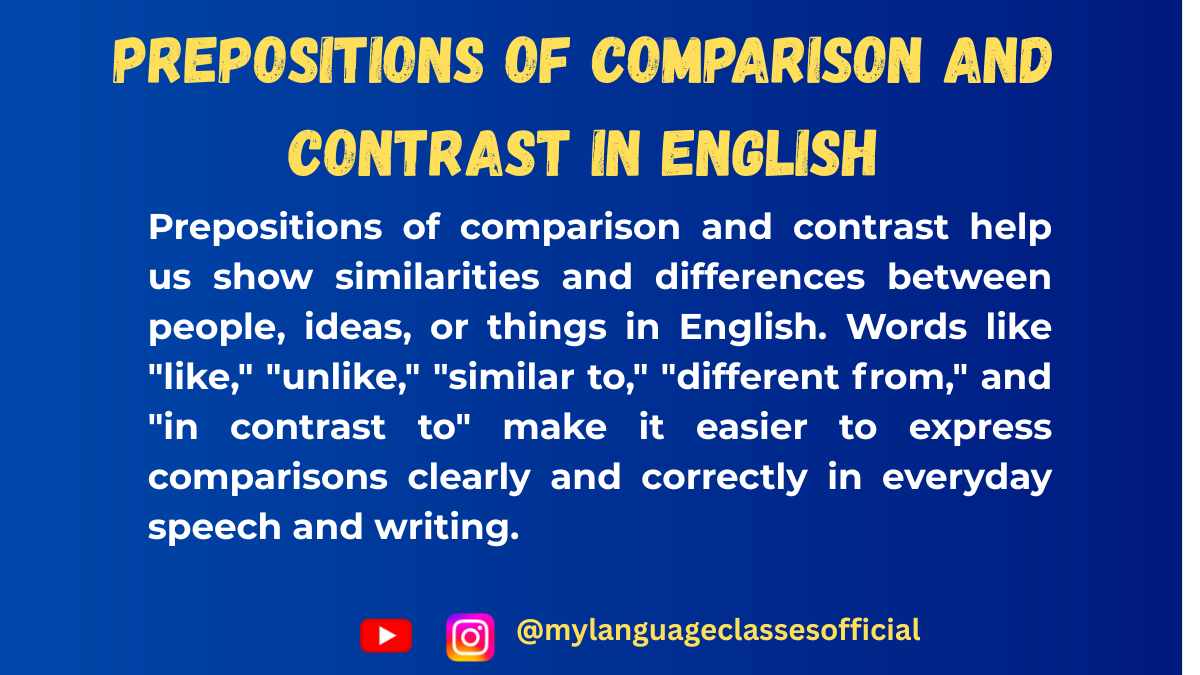Your cart is currently empty!
Tag: English grammar prepositions
-
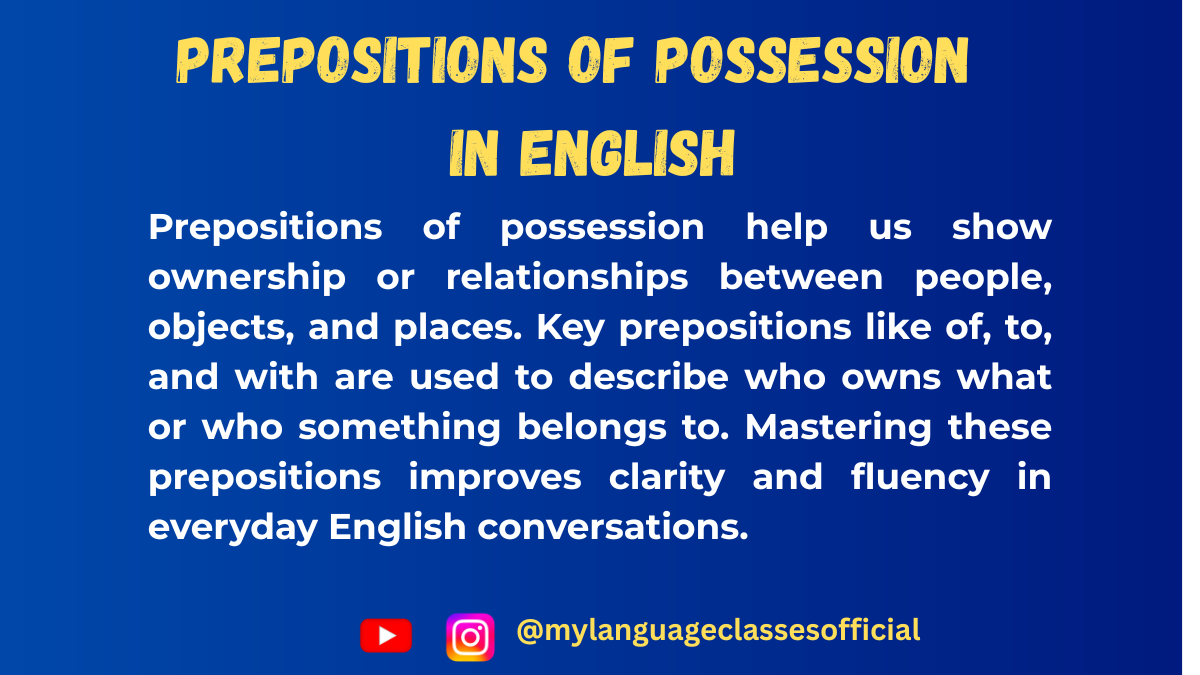
Prepositions of Possession in English
Prepositions of possession are words that indicate ownership, relationship, or belonging. They show how something or someone is related to another person or thing. In this blog post, we will discuss prepositions of possession in detail, their different usages, and provide numerous examples to help you master their application.
List of Prepositions of Possession
Below is a list of prepositions of possession along with their meanings and example sentences:
Preposition Meaning Example Sentence 1 Example Sentence 2 Of Indicates belonging or relation The pages of the book are torn. She is a friend of mine. To Shows possession, especially relationships This pen belongs to me. The key to the door is lost. With Indicates possession through an attribute or characteristic The boy with blue eyes is my cousin. She is the one with the golden necklace. By Can show authorship or ownership This novel is written by J.K. Rowling. The house by the river is beautiful. From Sometimes used to show possession or origin This advice came from my father. The letter from John is on the table. In Can indicate possession in certain contexts The error in the report must be corrected. There is wisdom in his words. For Can imply possession or association This gift is for my mother. The medal for bravery was awarded to him. About Sometimes used to indicate possession or relation The book about Shakespeare is very informative. There is a rumor about the new manager.
Situations Where Prepositions of Possession Are Used
- Indicating Ownership:
- Example: The cover of the book is blue.
- Describing Relationships:
- Example: He is a friend of mine.
- Attributing Characteristics:
- Example: The girl with curly hair is my sister.
- Denoting Authorship:
- Example: The poem by Robert Frost is inspiring.
- Showing Source or Origin:
- Example: The idea from our teacher was brilliant.
- Expressing Purpose or Benefit:
- Example: The scholarship for international students is available.
- Connecting Items with a Relationship:
- Example: The door to the basement is locked.
- Discussing Characteristics:
- Example: The car with tinted windows looks stylish.
- Using Articles with Prepositions of Possession:
- Example: A book of knowledge is valuable.
- Considering Gender in Possession:
- Example: The daughter of the king is the princess.
More Example Sentences
- The rules of the game are easy to understand.
- The key to my house is missing.
- She is the woman with the red umbrella.
- The novel by Charles Dickens is a classic.
- The letter from my mother made me emotional.
- The decision in the meeting was unanimous.
- The gift for my sister arrived today.
- There is a rumor about the new project.
- The map of the city is detailed.
- The teacher with a kind heart always helps students.
Fill in the Blanks
- The color ___ the car is red.
- The necklace ___ diamonds is expensive.
- The painting ___ Leonardo da Vinci is famous.
- This letter is ___ my best friend.
- The answer ___ the question is correct.
- The story ___ Harry Potter is interesting.
- The dog ___ the brown spots is friendly.
- The scholarship ___ outstanding students is competitive.
- The door ___ the balcony is open.
- The sound ___ the guitar is soothing.
Answers
- of
- with
- by
- from
- to
- about
- with
- for
- to
- of
Things to Keep in Mind
- Context Matters: The same preposition can have different meanings in different sentences.
- Articles (a, an, the): These should be used correctly with prepositions of possession.
- Gender Awareness: When referring to possession related to people, gender-specific words like his, her, or their may be necessary.
- Fixed Expressions: Some prepositions of possession appear in fixed expressions, like a friend of mine.
- Word Order: Ensure proper sentence structure when using prepositions of possession.
Conclusion
Mastering prepositions of possession is essential for fluency in English. They help establish relationships between people, objects, and ideas. By understanding their different uses and practicing with examples, you can use them naturally in conversations and writing. Keep practicing, and soon, using prepositions of possession will become second nature!
If you enjoyed this lesson, be sure to check out more posts like this on my blog at My Language Classes. Don’t forget to subscribe my YouTube channel and follow me on Instagram for the latest language learning tips and lessons. Leave a comment below to share your thoughts, or ask any questions you have about nouns.
Happy learning! 😊
- Indicating Ownership:
-
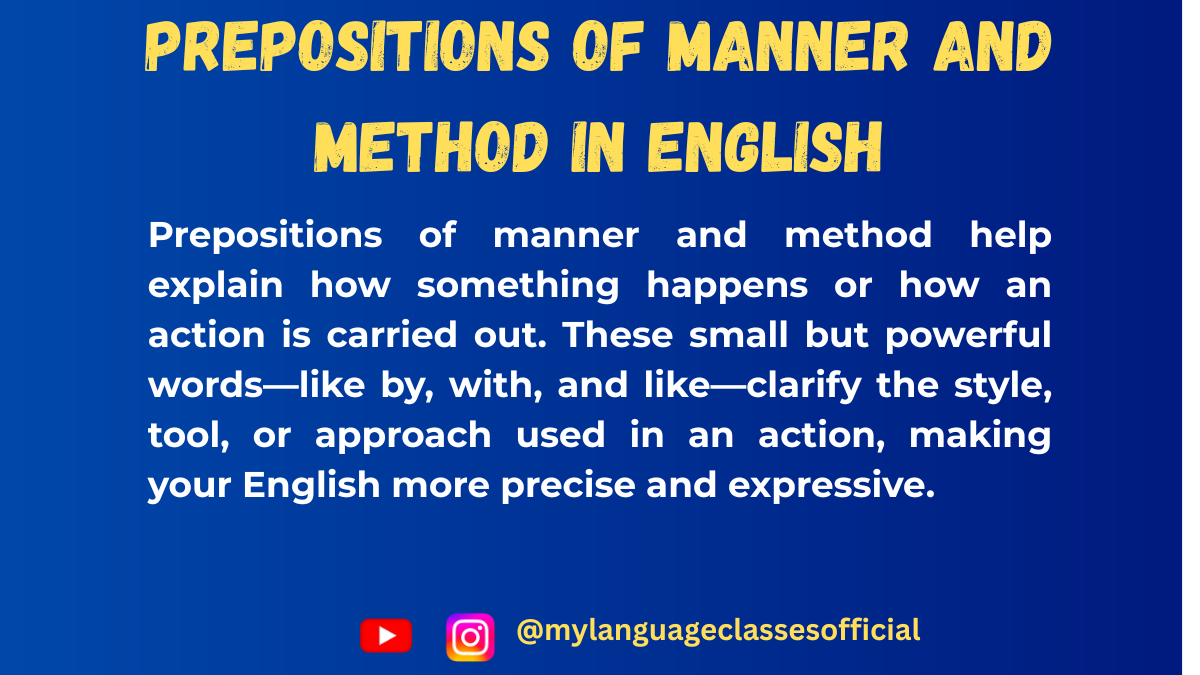
Preposition of Manner and Method in English
Prepositions play a crucial role in English grammar by linking words and phrases to express relationships. Among them, prepositions of manner and method describe how something happens or how an action is performed. Understanding these prepositions will help in constructing clear and precise sentences.
Usage of Prepositions of Manner and Method
Prepositions of manner and method are used to describe the way an action is carried out. They answer the question “How?” and provide clarity on the mode of an action. These prepositions are commonly used with verbs to indicate how something is done.
Situations Where Prepositions of Manner and Method Are Used:
- Describing Actions – How an action is performed (e.g., “She spoke with confidence.”)
- Means of Communication – How messages are conveyed (e.g., “I informed him by email.”)
- Transportation Methods – How a person travels (e.g., “He came by car.”)
- Instruments or Tools Used – What is used to perform an action (e.g., “He wrote with a pen.”)
- Style or Behavior – How someone behaves or reacts (e.g., “She acted in a rude manner.”)
- Work Process – How work is done (e.g., “The task was completed in a professional way.”)
- Payment Methods – How a transaction is made (e.g., “I paid by credit card.”)
- Languages Spoken – How something is expressed (e.g., “He explained it in Spanish.”)
- Order or Sequence – The manner in which events take place (e.g., “He explained step by step.”)
- Emotions or Attitude – The manner in which emotions are displayed (e.g., “She answered with a smile.”)
List of Prepositions of Manner and Method
Below is a table listing common prepositions of manner and method along with example sentences:
Preposition Example Sentence 1 Example Sentence 2 by She traveled by train. I sent the message by email. with He cut the paper with scissors. She painted the picture with a brush. in She spoke in a soft voice. He completed the work in a hurry. on They talked on the phone. He arrived on time. through He learned French through practice. She succeeded through hard work. via We will communicate via email. He sent the money via bank transfer. like She ran like the wind. He behaves like a child. as He worked as a manager. She acted as his assistant. using He repaired the machine using a tool. She solved the problem using logic. without She did it without hesitation. He left without saying goodbye.
More Example Sentences
- He performed the task with great skill.
- The letter was sent by post.
- She communicated via video call.
- He completed the test without any difficulty.
- She entered the room in a hurry.
- He fixed the issue using his knowledge.
- The news was delivered on the radio.
- The decision was made through consensus.
- She danced like a professional.
- The work was done in an efficient manner.
Fill in the Blanks
- He traveled to work ___ bus.
- She wrote the essay ___ a pen.
- The information was sent ___ email.
- He spoke ___ a soft voice.
- She completed the project ___ hard work.
- They communicated ___ phone.
- He handled the situation ___ patience.
- The machine was repaired ___ a screwdriver.
- The announcement was made ___ the radio.
- She left the meeting ___ saying a word.
Answers:
- by
- with
- by
- in
- through
- on
- with
- using
- on
- without
Things to Keep in Mind
- “By” is commonly used to indicate means of transport, communication, and payment.
- “With” is used for tools, instruments, and emotions.
- “In” is used for style, behavior, and emotions.
- “On” is used for communication and time.
- “Through” is used for processes and effort.
- “Via” is a more formal way to express routes or channels.
- “Like” and “as” should not be confused; “like” is used for comparisons, whereas “as” refers to roles or functions.
- “Using” highlights the method or tool employed.
- “Without” indicates absence or lack of something.
Conclusion
Prepositions of manner and method are essential for expressing the way an action is performed. They enhance clarity and precision in speech and writing. By understanding their correct usage, learners can improve their fluency and effectiveness in communication. Keep practicing, and soon, using these prepositions will become second nature!
If you enjoyed this lesson, be sure to check out more posts like this on my blog at My Language Classes. Don’t forget to subscribe my YouTube channel and follow me on Instagram for the latest language learning tips and lessons. Leave a comment below to share your thoughts, or ask any questions you have about nouns.
Happy learning! 😊
-
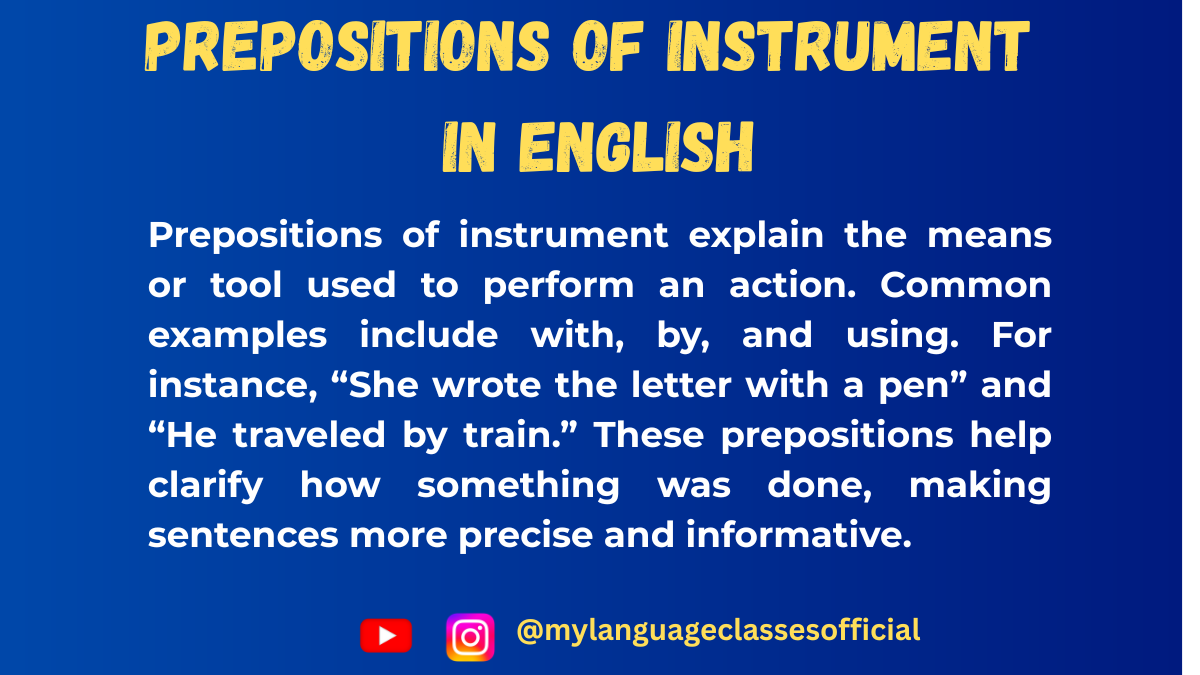
Prepositions of Instrument in English
Prepositions of instrument are used to indicate the means or tools used to perform an action. These prepositions show how something happens or is achieved. They are crucial in English grammar, as they help provide clarity in sentences.
Usage of Prepositions of Instrument
Prepositions of instrument are used in various situations, such as:
- With Tools or Instruments – Used when referring to a tool or instrument that helps complete an action.
- With Modes of Transport – Used when talking about how someone travels.
- With Means of Communication – Used when referring to ways of sending or receiving information.
- With Body Parts – Used when describing actions performed using body parts.
- With Natural Forces – Used when mentioning how something is affected by nature.
- With Materials or Substances – Used to describe the material used to create something.
- With Assistance – Used when referring to a person or thing that helps achieve something.
- With Measurement and Currency – Used when expressing amounts or ways of measuring.
List of Prepositions of Instrument
Preposition Example Sentence 1 Example Sentence 2 by She wrote the letter by hand. He traveled by car. with He cut the paper with scissors. She painted the wall with a brush. through They communicated through email. The water flows through the pipe. using He solved the problem using a calculator. She opened the door using a key. by means of The data was transferred by means of a USB drive. He escaped by means of a secret tunnel. via The message was sent via email. We traveled via London. on She swore on her mother’s life. He played a song on the piano. in The message was written in ink. She expressed her feelings in words. through the use of The document was signed through the use of an electronic pen. The problem was solved through the use of technology. by way of They reached the village by way of the river. He sent the package by way of courier.
More Example Sentences
- She cut the vegetables with a sharp knife.
- He sent me a message via WhatsApp.
- The report was written in pencil.
- We traveled to the city by train.
- He operates the machine using a remote control.
- She delivered the speech through a microphone.
- The bridge collapsed by means of an explosion.
- The poem was written on a piece of parchment.
- The artist sketched the portrait with charcoal.
- They recorded the lecture through the use of a digital recorder.
Fill in the Blanks
- He fixed the broken chair ___ a hammer.
- She traveled to Paris ___ plane.
- The students communicated ___ email.
- He ate the soup ___ a spoon.
- The announcement was made ___ a loudspeaker.
- The letter was written ___ a ballpoint pen.
- They cut the paper ___ scissors.
- The transaction was completed ___ an online payment system.
- The thief entered the house ___ a secret passage.
- The message was transmitted ___ radio waves.
Answers
- with
- by
- through
- with
- through
- in
- with
- using
- by means of
- via
Things to Keep in Mind
- Prepositions of instrument often indicate the method, means, or tools used to perform an action.
- Some prepositions, like by and with, are commonly interchangeable but depend on context.
- The choice of preposition can sometimes depend on the verb in the sentence.
- Articles (a, an, the) may be required before the instrument (e.g., “with a knife”).
- Gender does not play a role in English prepositions, unlike some other languages.
Conclusion
Prepositions of instrument are essential in English to convey how actions are performed. Understanding their correct usage will help improve clarity and precision in communication. By mastering these prepositions, learners can express themselves more effectively in various situations, whether discussing tools, travel, communication, or assistance.
If you enjoyed this lesson, be sure to check out more posts like this on my blog at My Language Classes. Don’t forget to subscribe my YouTube channel and follow me on Instagram for the latest language learning tips and lessons. Leave a comment below to share your thoughts, or ask any questions you have about nouns.
Happy learning! 😊
-
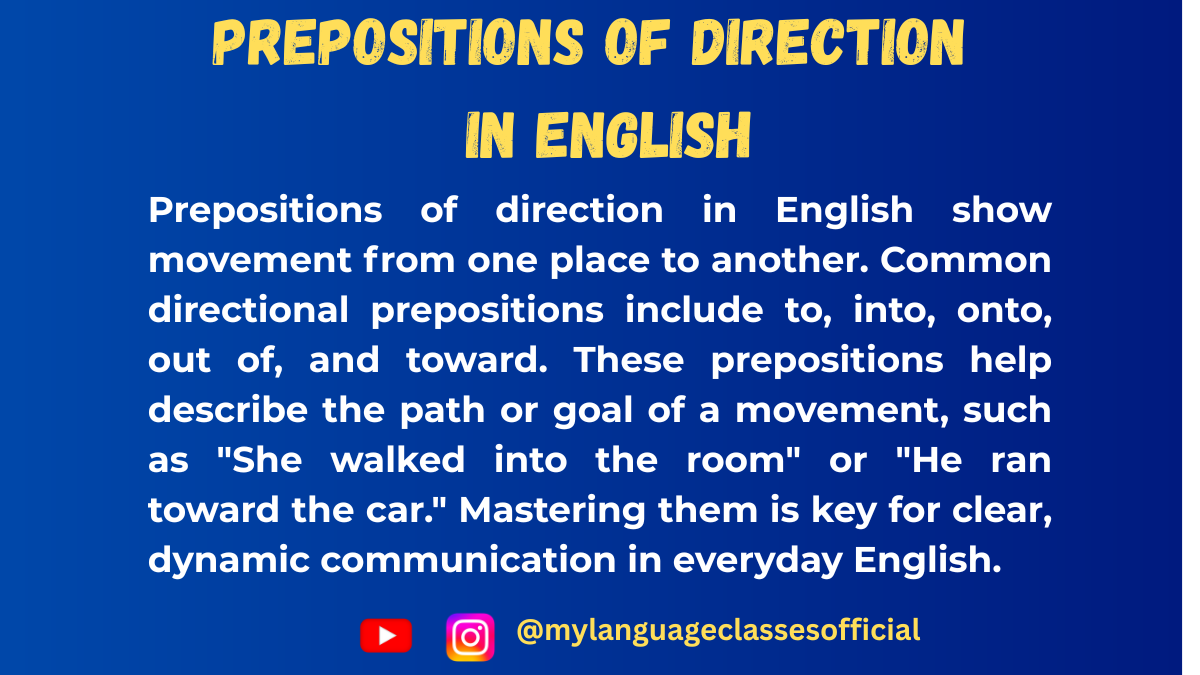
Prepositions of Direction in English
Prepositions of direction indicate movement from one place to another. They are essential in describing how something moves or changes position concerning another object.
List of Prepositions of Direction and Their Usage
Preposition Meaning Example Sentence 1 Example Sentence 2 To Movement towards a destination She went to the park. He sent a letter to his friend. Into Movement from outside to inside She walked into the room. The cat jumped into the box. Onto Movement towards a surface The child climbed onto the table. He jumped onto the bed. Out of Movement from inside to outside She ran out of the house. He took his phone out of his pocket. Towards Movement in the direction of something She moved towards the door. He walked towards me with a smile. Away from Movement in the opposite direction She walked away from the fire. The dog ran away from the stranger. Up Movement from a lower position to a higher one He climbed up the hill. The plane soared up into the sky. Down Movement from a higher position to a lower one The ball rolled down the hill. She walked down the stairs. Across Movement from one side to another He swam across the river. The children ran across the street. Over Movement above something The bird flew over the lake. He jumped over the fence. Under Movement beneath something The dog crawled under the table. The ball rolled under the chair. Along Movement following a path He walked along the beach. The car drove along the highway. Past Movement beyond a certain point They walked past the school. He drove past the mall. Through Movement within a space from one end to another She ran through the tunnel. The wind blew through the trees. Around Movement in a circular direction He walked around the park. The car drove around the roundabout.
More Example Sentences
- The boy ran to his mother as soon as he saw her.
- She poured the coffee into the cup carefully.
- He jumped onto the boat from the dock.
- The cat ran out of the house when the door was open.
- The athlete sprinted towards the finish line.
- They moved away from the dangerous area.
- The monkey climbed up the tree quickly.
- She walked down the street, enjoying the fresh air.
- He drove across the city to meet his friend.
- The plane flew over the mountains.
Fill in the Blanks
- She jumped ___ the swimming pool.
- He walked ___ the tunnel to reach the other side.
- The dog ran ___ the street to chase the cat.
- The helicopter flew ___ the buildings.
- He climbed ___ the ladder to fix the roof.
- The train passed ___ the bridge.
- The girl moved ___ the stage to receive her award.
- The kids walked ___ the road to reach school.
- The car drove ___ the highway without stopping.
- He ran ___ the hill with great speed.
Answers:
- into
- through
- across
- over
- up
- over
- towards
- across
- along
- down
Things to Keep in Mind
- Prepositions of direction always describe movement from one place to another.
- Some prepositions like to and towards may seem similar but have different uses (e.g., “to” specifies the destination, while “towards” indicates movement in a direction without necessarily reaching the destination).
- Prepositions such as into and onto describe entering or moving onto a surface, while in and on describe static positions.
- Over and under describe movement above and below something, respectively.
- Across and through both describe movement, but “across” is typically for flat surfaces, while “through” indicates movement within an enclosed space.
Conclusion
Prepositions of direction are essential for clear communication when describing movement and changes in position. Understanding their proper usage will enhance both written and spoken English. By practicing these prepositions in different contexts, you can develop a natural sense of their application and improve your fluency. Keep practicing with more sentences and exercises to master this important grammar topic!
If you enjoyed this lesson, be sure to check out more posts like this on my blog at My Language Classes. Don’t forget to subscribe my YouTube channel and follow me on Instagram for the latest language learning tips and lessons. Leave a comment below to share your thoughts, or ask any questions you have about nouns.
Happy learning! 😊
-

Prepositions of Place in English
Prepositions of place are essential in English as they help indicate the location of people, objects, or actions. Understanding them correctly enhances fluency and accuracy in spoken and written English. This article will provide a detailed explanation, a categorized list, examples, exercises, and essential things to remember while using prepositions of place.
What is a Preposition of Place?
A preposition of place is a word used to show the location or position of an object concerning another object. These prepositions answer the question “Where?” and are essential for clear communication.
List of Prepositions of Place and Their Usage
Below is a list of commonly used prepositions of place along with their meanings and example sentences.
Preposition Usage Example 1 Example 2 In Inside a space, area, or container The books are in the bag. She is in the room. On On the surface of something The book is on the table. There is a painting on the wall. At A specific point or location She is at the bus stop. We met at the restaurant. Under Below something The cat is under the table. He hid under the bed. Over Above something without touching The lamp is over the table. The bridge is over the river. Above Higher than something The clock is above the door. Planes fly above the clouds. Below Lower than something His shoes are below the bed. The valley is below the mountain. Between In the middle of two things The park is between the school and the mall. She sat between her friends. Next to Beside something The school is next to the hospital. She is sitting next to her brother. Behind At the back of something The car is behind the building. There is a garden behind the house. In front of Before something The teacher is in front of the class. There is a park in front of my house. Inside Within an enclosed space The keys are inside the drawer. She stayed inside the house. Outside Opposite of inside The kids are playing outside the house. There is a cat outside the shop. Near Close to something There is a bank near my house. She lives near the station. Far from Distant from something His school is far from his home. The hotel is far from the airport.
More Example Sentences:
- There is a mirror on the wall.
- The plane is flying above the clouds.
- She is waiting at the entrance.
- The ball is under the chair.
- The bakery is next to the supermarket.
- He kept his phone inside his pocket.
- The children are playing outside the house.
- The library is between the coffee shop and the bank.
- The painting is hanging over the sofa.
- There is a tree behind the house.
Fill in the Blanks:
- The cat is ___ the table.
- The park is ___ the school and the library.
- She is waiting ___ the bus stop.
- The ball rolled ___ the couch.
- The students are sitting ___ the teacher.
- The books are ___ the bag.
- The hotel is ___ the beach.
- The keys are ___ the drawer.
- He is standing ___ the door.
- The stars are shining ___ the sky.
Answers:
- under
- between
- at
- under
- in front of
- in
- near
- inside
- behind
- above
Things to Keep in Mind:
- Articles: Use definite and indefinite articles appropriately (e.g., “in a house” vs. “in the house”).
- Gender & Number: Prepositions of place do not change based on gender but may be influenced by singular/plural usage (e.g., “between two buildings”).
- Fixed Expressions: Some prepositions are part of set phrases, such as “at home,” “on the street,” or “in bed.”
- Context Matters: Some prepositions can change meaning based on the context (e.g., “on the bus” vs. “in the car”).
- Prepositions vs. Adverbs: Some words can function as both prepositions and adverbs. For example, “inside” can be a preposition in “inside the house” but an adverb in “Come inside!”
Conclusion
Prepositions of place are fundamental in English grammar and crucial for describing locations accurately. By understanding their usage and practicing them through exercises, you can significantly improve your English fluency. Keep practicing with real-life situations, and soon, using prepositions of place will become second nature!
If you enjoyed this lesson, be sure to check out more posts like this on my blog at My Language Classes. Don’t forget to subscribe my YouTube channel and follow me on Instagram for the latest language learning tips and lessons. Leave a comment below to share your thoughts, or ask any questions you have about nouns.
Happy learning! 😊

